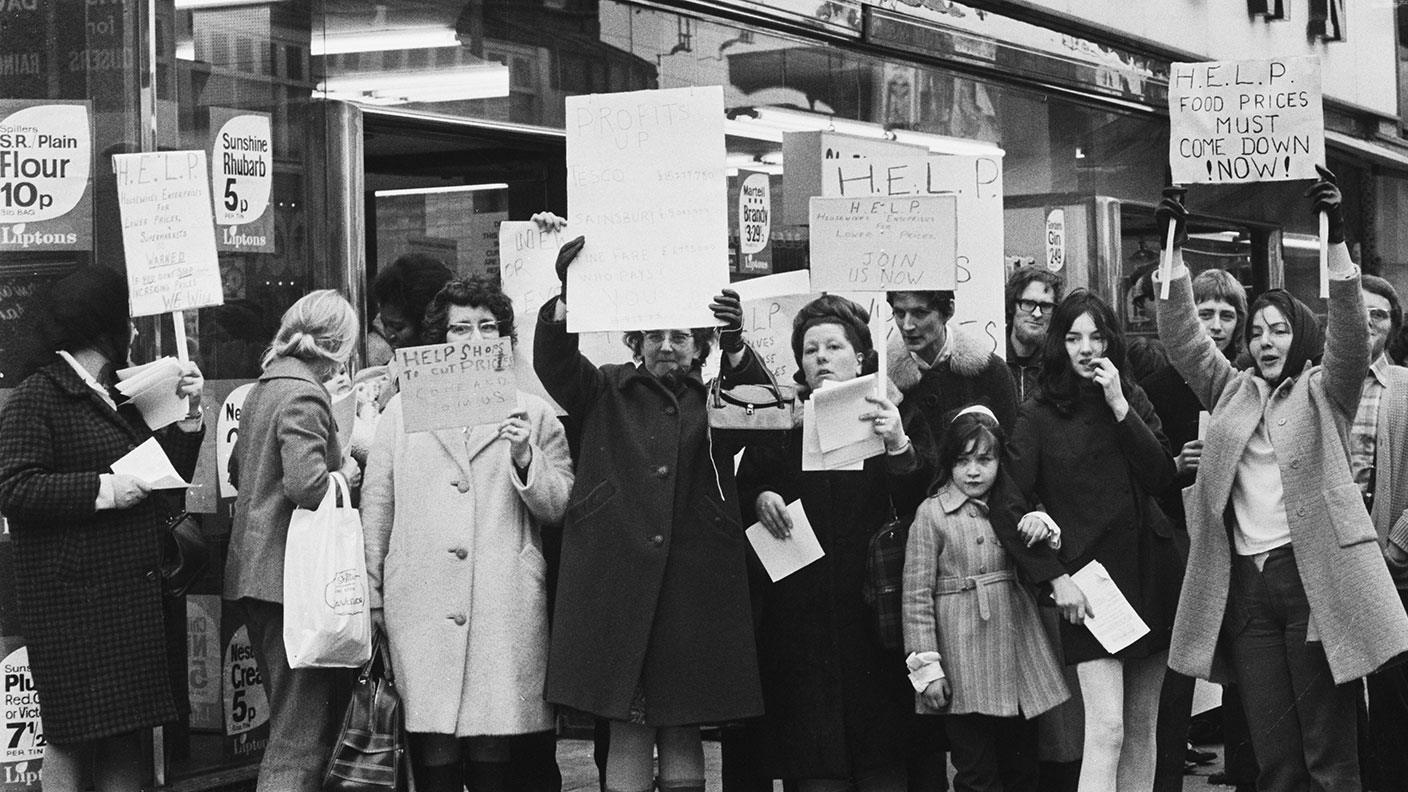This isn’t the stagflationary 1970s – but neither is it the low-rate world of the 2010s
With soaring energy prices and high inflation, it might seem like we’re on a fast track back to the 1970s. We’re not, says Merryn Somerset Webb. But we’re not going back to the 2010s either.


Those of us who remember the 1970s, even as children, are getting nervous. No decade is all bad, but very few of us would like a repeat of the inflation, the endless financial stress, the poverty – and, in the case of many families (mine included), the migration in search of work. Unfortunately, so far the 2020s are feeling rather too much like the 1970s for comfort.
Dario Perkins of research group TS Lombard – our latest guest on the MoneyWeek Podcast – lists the ways: the 1960s saw one of the longest expansions on record and a flattening of the Phillips curve – that is, falling unemployment was not correlating with rising inflation in the way one might expect.
That emboldened policymakers to both prioritise full employment over low inflation (inflation did not appear to be the relevant risk) and to develop more activist fiscal policy.
MoneyWeek
Subscribe to MoneyWeek today and get your first six magazine issues absolutely FREE

Sign up to Money Morning
Don't miss the latest investment and personal finances news, market analysis, plus money-saving tips with our free twice-daily newsletter
Don't miss the latest investment and personal finances news, market analysis, plus money-saving tips with our free twice-daily newsletter
This was the backdrop to a fabulous bull market. The FTSE All-Share index doubled in the two years to January 1969, when it peaked on a record price/earnings ratio of 23 times.
Then came a huge energy shock which built on previous inflationary rumblings. The Phillips curve normalised, wages started rising and the money supply surged. Policymakers blamed temporary factors – and stripped them out of the inflation numbers they used as their reference point. It was “transitory”, you see.
This isn’t the 1970s…
It sounds horribly familiar, doesn’t it? Particularly now that, notwithstanding last Thursday’s sharp fall in the oil price, the energy price shock of the past few weeks is of 1970s-style magnitude.
Perkins is not convinced that we need to get as tense as I am beginning to feel. There is, he says, a huge and crucial difference between now and then, in the UK at least: then, labour had power; now it does not. Our population is not so young and “militant”, our trade unions are weak, our markets are much more open (companies can’t get away with price rises in the same way) and pretty much no one – pensioners and MPs aside – has their income in any way indexed to inflation. All that means that a wage price spiral can’t get going in quite the same way.
He might be right. I’d argue that workers will rebuild their bargaining power pretty quickly in the face of CPI inflation hitting 10%. It is worth remembering that in the 1960s pay lagged behind inflation for some time before pressures appeared. There were murmurs in 1966 from the railways and the coal mines and things then took a turn for the seriously worse in late 1969 when Ford Motor workers went out on strike.
…but it’s not the 2010s either
Still, whichever one of us is more right – forecasters are rarely completely right – one thing is for sure: we won’t be going back to the 2010s.
The deflation machine that has been the driving force of the past few decades is properly broken, something that is fast turning out to be a terrible shock to fund managers who have only ever worked inside said machine, and so have hard-wired into their behaviour an assumption that moderate inflation and low interest rates would last for ever.
With globalisation reversing, labour costs at best no longer falling and the structural supply problem with materials and energy increasingly obvious, prices of pretty much everything must now rise. A reminder for those who think there is an easy way out: you need fossil fuels to make wind turbine blades and solar panels and you need a lot of nickel – up 90% in two weeks – to make electric car batteries.
The question is just how much prices must rise, how fast and with how much volatility. That we can’t know. The war in Ukraine gives us some unpleasant clues about the short term (up a lot very quickly, and with a lot of volatility) but the overlay of uncertainty means we can’t guess much more than that. Who knows, for example, what might result from attempts by money-printing governments to protect households from the sharply rising food prices caused by the horrors in one of the world’s most reliable producers of grain?
How can you invest?
So where are the financial safe havens? You might think that as long as inflation stays around 1% to 4% (Perkins’ guess) you’ll be safe in equities. That’s what we are often told, but it isn’t always so.
UK inflation only tipped over 5% in 1969, but investors still lost out hugely in the 1960s: the market went up 20% and prices went up 43%. Extend it into the stagflationary 1970s and things look pretty bad too: from October 1964 to May 1979, a period which encompasses two Labour governments and one Conservative, UK stockmarket investors lost 31.7% of their money in inflation-adjusted terms.
So much for the idea that an equity index can protect you from inflation, stagflation – or indeed anything else. The good news is that the one way an equity market can protect you is if you buy it at the bottom – the best long-term returns come from buying cheap markets.
It would be nice to think some markets are nearly there – particularly the US, which is at less risk of war-related recession than Europe – but they aren’t. For that, we would need to be sure there was another wave of central bank money on the way, to know that energy prices are on the way down and to be sure that valuations are compelling. None of these things are true, or anywhere near to being true. For example, the Shiller price/earnings ratio for the US is still over 30 times, against a long-term average of more like 16 times.
Waiting for them to be true is a slow process. Russell Napier, a market historian, likes to point out that the four great bear markets in the US lasted on average nine years each. In the intervening period, you should get some protection from commodities and from gold – you did in the 1970s.
But you would also be wise to look at multi-asset funds run by managers who have long known that the deflationary machine would break and who are invested accordingly. Look at Ruffer Investment Company (LSE: RICA), which is up a little in the year to date, Personal Assets Trust (LSE: PNL) and Capital Gearing Trust (LSE: CGT). They are more ready than most.
• This article was first published in the Financial Times
Get the latest financial news, insights and expert analysis from our award-winning MoneyWeek team, to help you understand what really matters when it comes to your finances.
Merryn Somerset Webb started her career in Tokyo at public broadcaster NHK before becoming a Japanese equity broker at what was then Warburgs. She went on to work at SBC and UBS without moving from her desk in Kamiyacho (it was the age of mergers).
After five years in Japan she returned to work in the UK at Paribas. This soon became BNP Paribas. Again, no desk move was required. On leaving the City, Merryn helped The Week magazine with its City pages before becoming the launch editor of MoneyWeek in 2000 and taking on columns first in the Sunday Times and then in 2009 in the Financial Times
Twenty years on, MoneyWeek is the best-selling financial magazine in the UK. Merryn was its Editor in Chief until 2022. She is now a senior columnist at Bloomberg and host of the Merryn Talks Money podcast - but still writes for Moneyweek monthly.
Merryn is also is a non executive director of two investment trusts – BlackRock Throgmorton, and the Murray Income Investment Trust.
-
 ‘Why I have ditched my Help to Buy ISA for cash savings and the stock market’
‘Why I have ditched my Help to Buy ISA for cash savings and the stock market’Without the 25% bonus, my Help to Buy ISA is effectively redundant, says MoneyWeek writer Sam Walker.
-
 Is your inheritance tax allowance cut if you sell to downsize or sell your home to pay for care?
Is your inheritance tax allowance cut if you sell to downsize or sell your home to pay for care?Downsizing relief is a little-known benefit that could save your loved ones tens of thousands of pounds in inheritance tax after you’ve died.
-
 Halifax: House price slump continues as prices slide for the sixth consecutive month
Halifax: House price slump continues as prices slide for the sixth consecutive monthUK house prices fell again in September as buyers returned, but the slowdown was not as fast as anticipated, latest Halifax data shows. Where are house prices falling the most?
-
 Rents hit a record high - but is the opportunity for buy-to-let investors still strong?
Rents hit a record high - but is the opportunity for buy-to-let investors still strong?UK rent prices have hit a record high with the average hitting over £1,200 a month says Rightmove. Are there still opportunities in buy-to-let?
-
 Pension savers turn to gold investments
Pension savers turn to gold investmentsInvestors are racing to buy gold to protect their pensions from a stock market correction and high inflation, experts say
-
 Where to find the best returns from student accommodation
Where to find the best returns from student accommodationStudent accommodation can be a lucrative investment if you know where to look.
-
 The world’s best bargain stocks
The world’s best bargain stocksSearching for bargain stocks with Alec Cutler of the Orbis Global Balanced Fund, who tells Andrew Van Sickle which sectors are being overlooked.
-
 Revealed: the cheapest cities to own a home in Britain
Revealed: the cheapest cities to own a home in BritainNew research reveals the cheapest cities to own a home, taking account of mortgage payments, utility bills and council tax
-
 UK recession: How to protect your portfolio
UK recession: How to protect your portfolioAs the UK recession is confirmed, we look at ways to protect your wealth.
-
 Buy-to-let returns fall 59% amid higher mortgage rates
Buy-to-let returns fall 59% amid higher mortgage ratesBuy-to-let returns are slumping as the cost of borrowing spirals.
